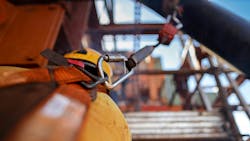Construction continues to be one of the most dangerous professions in the United States. In a 2022 report from the U.S. Bureau of Labor Statistics (BLS), over 1,000 construction workers died from workplace injuries. Falls were attributed to just over 20% of those fatalities, which is especially tragic because falls from heights are 100% preventable. If construction companies prioritize building awareness, providing effective training, and supplying the right equipment to their workers, they can start fostering stronger safety cultures that are better at identifying hazards and preventing tragedies.
Increasing awareness
While some employers worry that sharing industry safety statistics could scare some employees, it’s imperative to arm those employees with the knowledge on how to stay safe on the job site. If a company wants to ensure its people are working safely, one of the first steps is to make their workforce aware of the existing hazards on their job site and empower them to take action to mitigate those hazards. Oftentimes, safety managers make the mistake of believing that locating and mitigating every fall hazard on a job site is solely their responsibility, but if they include their entire crew in those efforts, it can amplify their effectiveness.
In the past, there was a taboo about reporting safety hazards on a job site because people didn’t want to be blamed for causing the hazard and risk being reprimanded. But now, many construction companies have attempted to eliminate this stigma by actually incentivizing employees to report unsafe working conditions or immediate safety hazards they find on the job site. For example, some companies give out gift cards when a worker finds/reports a safety hazard. This behavior provides more eyes and ears on a job site than any safety team could hope to have and brings workers of all levels together to find solutions. A good safety manager will ask the worker who addresses the hazard their opinion on mitigating the risk. This exercise increases the chance of implementing a solution the laborers will immediately adopt, as long as the safety manager confirms it complies with OSHA regulations and corporate policies.
Effective training
Fall protection training is not just a recommended practice for employers but is mandated by the Occupational Safety & Health Administration (OSHA). Employers must run employees through initial fall protection training that is specific to the work site and equipment supplied to them. OSHA refers to this training as authorized person training and must be given to any employee who will use fall protection equipment. There is no set retraining schedule set forth by OSHA, but many companies strive to host refresher trainings annually for workers at a minimum. OSHA requires retraining if an employee displays a gap of understanding in safe practices or whenever a change to the equipment, facility, or policies occurs. Until fall incident rates drop dramatically in this industry, there really is no such thing as too much training.
OSHA also mandates that each company has at least one dedicated, certified competent person. The competent person is, essentially, the facilitator of the fall protection program. Companies can have as many competent persons as they wish, and larger organizations would benefit from doing so. If a company does in-house authorized person training, the competent person is the only person with the authority to conduct those. The competent person is also the only one who can approve new equipment or anchorages and is responsible for the annual equipment inspections. According to ANSI Z359, the competent person certification must be refreshed every two years. These trainings are offered by fall protection manufacturers or other third-party ANSI-accredited training organizations.
According to a survey conducted by the Center for Construction Research and Training (CPWR), ineffective planning was the leading underlying cause of falls in construction. Regular trainings, team meetings, or toolbox talks can be effective and consistent ways to keep the topic of fall protection “top of mind” and ensure employees are caught up with current policies and protocols. These trainings can cover a wide breadth of topics but should primarily educate employees on the importance of using their fall protection consistently as well as using the equipment according to manufacturer instructions.
Selecting equipment
In the same CPWR survey mentioned above, the next two leading underlying causes of falls were neglecting to use supplied fall protection equipment and misuse of the equipment. It can be extremely frustrating for a company to go through the equipment selection process and still have falls occur on their job site, likely causing injury or worse. If a company wants to increase user compliance rates, it’s a good idea to involve frontline workers in the equipment selection process. If a worker’s equipment is uncomfortable or using a system is too cumbersome to finish their task, they are more likely to neglect using the equipment. Often, the best fall protection equipment is the equipment users will use every time.
Fostering stronger safety cultures
An important component in maintaining a robust fall protection program is routinely evaluating the program for its effectiveness and improving it over time. Improvements can be in the form of purchasing new equipment, inviting fall protection manufacturers to conduct in-depth training sessions, or incorporating more employees into the safety program. Companies must have total buy-in and a commitment to safety at all levels of the company (from executive leadership to entry-level frontline workers) if they want to build a strong safety culture.
According to the CPWR, employees who believed fall protection was required by their employer were eight times more likely to use fall protection, compared to those who did not believe fall protection was required. Additionally, the odds of employees using fall protection equipment were 71% lower for individuals whose employer or competent person did not do any planning. This data suggests that when leadership consistently reminds employees to properly use their fall protection equipment and stay aware of fall hazards, employees end up working safer.
Conclusion
The importance of fall protection on the job site cannot be understated. Approximately two to three workers die every day from falls. That rate has remained fairly consistent for the past decade. In fact, the past 30 years have seen a 17% increase in fatal falls. Companies must routinely evaluate their safety program to ensure they are effective, communicate with their frontline workers to ensure they are empowered to work safely, and educate them enough to know when new risks present themselves.
There is much progress to be made to drastically decrease the number of falls occurring in the workplace, but as the saying goes, “A journey of a thousand miles begins with a single step.” While these problems will not disappear overnight, consistent efforts to address this problem can have compounding, positive effects on worker safety in the (hopefully near) future.
About the Author

Philip Jacklin
Philip Jacklin is the Continuing Education Program Manager for Diversified Fall Protection. He is an AIA continuing ed provider, QSSP certified, OSHA-30 trained, and has been a partner to the fall protection industry since 2018. Philip has a background in worker advocacy, team leadership, and fostering camaraderie among peers. He enjoys playing music, writing, and spending time in the sunshine with his family in Virginia Beach, Va.
